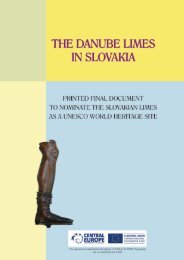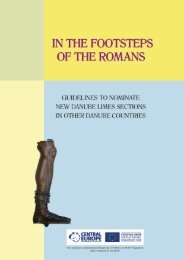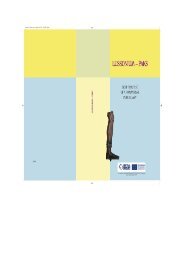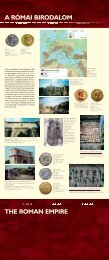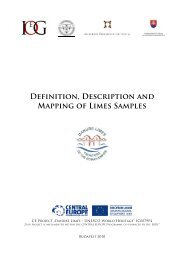the PDF version! - Danube Limes
the PDF version! - Danube Limes
the PDF version! - Danube Limes
Create successful ePaper yourself
Turn your PDF publications into a flip-book with our unique Google optimized e-Paper software.
Frontiers of <strong>the</strong> Roman Empire – Ripa Pannonica in Hungary (RPH) Nomination statement<br />
5.e.3 Management Plan<br />
According to <strong>the</strong> World Heritage law that is in <strong>the</strong> preparatory stage, <strong>the</strong> minister responsible for cultural<br />
heritage prepares and reviews <strong>the</strong> World Heritage management plan, and also administers <strong>the</strong> duties<br />
arising from it.<br />
The management plan is public and legally binding. The management plans for World Heritage sites and<br />
tentative sites are proclaimed in a decree by <strong>the</strong> Government.<br />
The management plan is attached as an appendix to <strong>the</strong> nomination documentation.<br />
5.f Sources and Levels of Finance<br />
There are various sources of funding for <strong>the</strong> management of <strong>the</strong> RPH.<br />
First of all, <strong>the</strong> World Heritage law provides funding for <strong>the</strong> operation of <strong>the</strong> publicly funded management<br />
organizations, and through <strong>the</strong>se for <strong>the</strong> Hungarian World Heritage sites. For sites owned by <strong>the</strong> Hungarian<br />
state, <strong>the</strong> Hungarian National Property Management Co. designates management organizations that<br />
cover <strong>the</strong> costs of managing and maintaining <strong>the</strong> sites through funds provided to <strong>the</strong>m from <strong>the</strong> state<br />
budget and from <strong>the</strong>ir own revenues obtained through <strong>the</strong>ir operation (e.g. ticket sales, publications, and<br />
from o<strong>the</strong>r proper uses etc.).<br />
Cultural assets receive significant prominence amongst <strong>the</strong> priorities of <strong>the</strong> National Development Plan. The<br />
government has <strong>the</strong> opportunity to declare <strong>the</strong> most important cultural programs for highlighted development.<br />
These receive support from central budgetary sources. Preservation projects that are not highlighted can receive<br />
support from domestic, European Union or o<strong>the</strong>r sources (e.g. <strong>the</strong> Norwegian Financial Mechanism) through<br />
<strong>the</strong> National Development Plan’s grant system in support of its priorities. The wide spectrum of <strong>the</strong> grant system<br />
is diverse, so it is open not only to state owned sites, but also those owned for example by local governments,<br />
companies or individuals as well. The terms of <strong>the</strong> grants generally require some funding from <strong>the</strong> organization’s<br />
own resources, although in some cases <strong>the</strong>re is an opportunity to cover this through o<strong>the</strong>r grants.<br />
5.g Sources of Expertise and Training in Conservation and Management<br />
Techniques<br />
The university training of archaeologists, ethnographers, art historians, architects, urban planners,<br />
landscape architects and regional planners in Hungary occurs throughout <strong>the</strong> country. Restoration experts<br />
are trained at <strong>the</strong> Hungarian University of Fine Arts. The professional standards and accreditation are<br />
overseen by professional associations. The system providing <strong>the</strong> conditions for maintaining professional<br />
expertise is comprehensively ensured.<br />
Archaeology:<br />
• Institute of Archaeological Science, Eötvös Loránd University, Faculty of Humanities, Budapest<br />
• Department of Archaeology, University of Szeged, Faculty of Arts, Szeged<br />
• Department of Archaeology, University of Pécs, Faculty of Humanities, Pécs<br />
96



